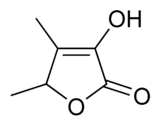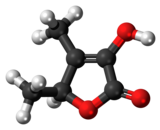Sotolon
 |
|
 |
|
| Names | |
|---|---|
|
IUPAC name
3-Hydroxy-4,5-dimethylfuran-2(5H)-one
|
|
| Other names
Sotolone
Caramel furanone Sugar lactone Fenugreek lactone |
|
| Identifiers | |
|
28664-35-9 |
|
| 3D model (Jmol) | Interactive image |
| ChemSpider | 56569 |
| ECHA InfoCard | 100.044.655 |
| PubChem | 62835 |
|
|
|
|
| Properties | |
| C6H8O3 | |
| Molar mass | 128.13 g·mol−1 |
| Density | 1.049 g/cm3 |
| Melting point | 26 to 29 °C (79 to 84 °F; 299 to 302 K) |
| Boiling point | 184 °C (363 °F; 457 K) |
|
Except where otherwise noted, data are given for materials in their standard state (at 25 °C [77 °F], 100 kPa).
|
|
|
|
|
| Infobox references | |
Sotolon (also known as sotolone) is a lactone and an extremely powerful aroma compound, with the typical smell of fenugreek or curry at high concentrations and maple syrup, caramel, or burnt sugar at lower concentrations. Sotolon is the major aroma and flavor component of fenugreek seed and lovage, and is one of several aromatic and flavor components of artificial maple syrup. It is also present in molasses, aged rum, aged sake and white wine, flor sherry, roast tobacco, and dried fruiting bodies of the mushroom Lactarius helvus. Sotolon can pass through the body relatively unchanged, and consumption of foods high in sotolon, such as fenugreek, can impart a maple syrup aroma to one's sweat and urine. In some individuals with the genetic disorder maple syrup urine disease, it is spontaneously produced in their bodies and excreted in their urine, leading to the disease's characteristic smell.
This molecule is thought to be responsible for the mysterious maple syrup smell that has occasionally wafted over Manhattan since 2005.
Sotolon was first isolated in 1975 from the herb fenugreek. The compound was named in 1980 when it was found to be responsible for the flavor of raw cane sugar: soto- means "raw sugar" in Japanese and -olon signifies that the molecule is an enol lactone.
Vin jaune is marked by the formation of sotolon from α-ketobutyric acid.
...
Wikipedia
